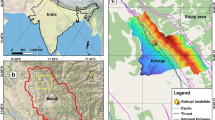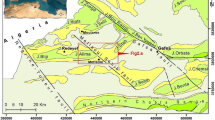Abstract
The Basu–Ranwu section of the Sichuan–Tibet railway is in an arid and tectonically active valley characterized by rugged topography, sharp river incision and severe debris flow events. The study aims to provide scientific support for the prevention and control of debris flow in this section by revealing the dynamic characteristics, main controlling factors and distribution rules of debris flow. Research based on the analysis of field investigation data, remote sensing images, DEM and geological map has yielded the following results: (1) the forty-eight debris flows in the study area can be divided into five types based on the formation conditions, which are zonally distributed along the fault zone and also varied vertically in space and depended on the hardness of the underlying strata. (2) A complex geological and environmental background has provided appropriate material sources and favourable potential energy conditions conducive to the formation of disastrous debris flows. Additionally, the development of debris flows was affected by antecedent earthquakes and droughts, and disastrous debris flows are triggered by an abundant source of water. (3) The study area is located in the arid area, where the rainfall runoff is small and the scale of debris flow is relatively small, except for a few glacial lake outburst debris flows; therefore, the debris flow in this section can be controlled; prevention modes of debris flow hazards have been proposed for the railway engineering based on the types of railway engineering and the scale and type of the debris flows. The results provide an important and object scientific basis for route selection for geological engineering projects and for the control of debris flows in the Basu–Ranwu section of the Sichuan–Tibet railway.







Similar content being viewed by others
References
Chen NS, Cui P, Liu ZG, Wei FQ (2003) Calculation of the debris flow concentration based on clay content. Sci Chin Ser E Technol Sci 46:163–174. https://doi.org/10.1360/03EZ0005
Chen CY, Chen TC, Yu FC, Yu WH, Tseng CC (2005) Rainfall duration and debris-flow initiated studies for real-time monitoring. Environ Geol 47(5):715–724. https://doi.org/10.1007/s00254-004-1203-0
Chen XQ, Cui P, Feng ZL, Chen J, Li Y et al (2006) Artificial rainfall experimental study on landslide translation to debris flow. Chin J Rock Mech Eng 25:106–116 (in Chinese)
Chen NS, Hu GS, Deng MF, Zhou W, Yang CL, Han D, Deng JH (2011) Impact of earthquake on debris flows-a case study on the Wenchuan earthquake. J Earthq Tsunami 5(5):493–508. https://doi.org/10.1142/S1793431111001212
Chen NS, Lu Y, Zhou HB, Deng MF, Han DW (2014) Combined impacts of antecedent earthquakes and droughts on disastrous debris flows. J Mount Sci 11(6):1507–1520. https://doi.org/10.1007/s11629-014-3080-7
Du RH (1985) The research on glacial debris flow in Tibet. Sinica 4 of Lanzhou Institute of Glaciology and Cryopedology, Chinese Academy of Sciences. Beijing: Science Press. pp 1-69 (in Chinese)
Gabet EJ, Mudd SM (2006) The mobilization of debris flows from shallow landslides. Geomorphology 74:207–218. https://doi.org/10.1016/j.geomorph.2005.08.013
Gan WJ, Zhang PZ, Shen ZK, Niu ZJ, Wang M, Wan YG, Zhou DM, Cheng J (2007) Present-day crustal motion within the Tibetan Plateau inferred from GPS measurements. J Geophys Res 112:B08416. https://doi.org/10.1029/2005JB004120
Hong L, Ouyang M, Peeta S, He XZ, Yan YZ (2015) Vulnerability assessment and mitigation for the Chinese railway system under floods. Reliab Eng Syst Saf 137:58–68. https://doi.org/10.1016/j.ress.2014.12.013
Hsu CH, Tsao TC, Huang CM, Lee CF, Lee YT (2016) Using remote sensing techniques to identify the landslide hazard prone sections along the south link railway in Taiwan. Proc Eng 143:708–716. https://doi.org/10.1016/j.proeng.2016.06.107
Hu W, Xu Q, Rui C, Huang RQ, van Asch TWJ, Zhu X, Xu QQ (2015) An instrumented flume to investigate the initiation mechanism of the post-earthquake huge debris flow in the southwest of China. Bull Eng Geol Environ 74:393–404. https://doi.org/10.1007/s10064-014-0627-3
IMHE (Institute of Mountain Hazards and Environment, the Chinese Academy of Sciences and Water Conservancy Ministry), CARE (Cold and Arid Regions Environmental and Engineering Research Institute, Chinese Academy of Sciences), and ITS (Institute of the Traffic Science, the Traffic Department of the Tibet Autonomous Region) (1995) Mountain hazards in south branch of Sichuan–Tibet Highway (within Tibet) and treatment measurements. Science Press, Beijing, 253 (in Chinese)
Irmler R, Daut G, Mäusbacher R (2006) A debris flow calendar derived from sediments of lake Lago di Braies (N. Italy). Geomorphology 77:69–78. https://doi.org/10.1016/j.geomorph.2006.01.013
Iverson RM, Reid ME, Logan M, LaHusen RG, Godt JW, Griswold JP (2010) Positive feedback and momentum growth during debris-flow entrainment of wet bed sediment. Nat Geosci 4:116–121. https://doi.org/10.1038/ngeo1040
Kessler JLP, Soreghan GS, Wacker HJ (2001) Equatorial aridity in western Pangea: lower Permian loessite and dolomitic paleosols in northeastern New Mexico, USA. J Sedim Res 71:817–832. https://doi.org/10.1306/2DC4096B-0E47-11D7-8643000102C1865D
Lan HX, Martin CD, Zhou CH (2008) Estimating the size and travel distance of Klapperhorn Mountain debris flows for risk analysis along railway, Canada. Int J Sedim Res 23:275–282. https://doi.org/10.1016/S1001-6279(08)60025-6
Li SD, Ren XS, Yue SY (2001) Earthquake and debris flow activities. Res Soil Water Conserv 8:26–27 (in Chinese)
Lin CW, Shieh CL, Yuan BD, Lee SY (2004) Impact of Chi–Chi earthquake on the occurrence of landslides and debris flows: example from the Chenyulan River watershed, Nantou, Taiwan. Eng Geol 71:49–61. https://doi.org/10.1016/S0013-7952(03)00125-X
Liu CY (2003) Effects of earthquake on mud-rock flows. Shanxi Architect 29(7):40–41 (in Chinese)
Liu CN, Dong JJ, Peng YF, Huang HF (2009) Effects of strong ground motion on the susceptibility of gully type debris flows. Eng Geol 104:241–253. https://doi.org/10.1016/j.enggeo.2008.10.012
Meng LB, Li TB, Jiang Y, Wang R, Li YR (2013) Characteristics and mechanisms of large deformation in the Zhegu mountain tunnel on the Sichuan–Tibet highway. Tunn Undergr Space Technol 37:157–164. https://doi.org/10.1016/j.tust.2013.03.009
Ryan HF, Legg MR, Conrad JE (2009) Recent faulting in the gulf of Santa Catalina: San Diego to Dana Point. Earth Science in the Urban Ocean. S Calif Contin Borderl Geol Soc Am Spec Pap 454:291–315. https://doi.org/10.1130/2009.2454(4.5)
Sepúlveda SA, Padilla C (2008) Rain-induced debris and mudflow triggering factors assessment in the Santiago cordilleran foothills, Central Chile. Nat Hazard 47(2):201–215. https://doi.org/10.1007/s11069-007-9210-6
Shang YJ, Park HD, Yang ZF (2005) Engineering geological zonation using interaction matrix of geological factors: an example from one section of Sichuan–Tibet Highway. Geosci J 9(4):375–387
Song Z, Zhang G, Jiang LW, Wu G (2016) Analysis of the characteristics of major geological disasters and geological alignment of Sichuan–Tibet Railway. Railw Stand Des 60(1):14–49 (in Chinese)
Staley DM, Kean JW, Cannon SH, Schmidt KM, Laber JL (2012) Objective definition of rainfall intensity–duration thresholds for the initiation of post-fire debris flows in southern California. Landslides 10:547–562. https://doi.org/10.1007/s10346-012-0341-9
Tang C, Zhu J, Li WL, Liang JT (2009) C. Rainfall-triggered debris flows following the Wenchuan earthquake. Bull Eng Geol Environ 68:187–194. https://doi.org/10.1007/s10064-009-0201-6
Tang C, Asch TWJ, Chang M, Chen GQ, Zhao XH, Huang XC (2012) Catastrophic debris flows on 13 August 2010 in the Qingping area, southwestern China: the combined effects of a strong earthquake and subsequent rainstorms. Geomorphology 140:559–576. https://doi.org/10.1016/j.geomorph.2011.12.021
The Geological and Mineral Industry Standard of the People’s Republic of China (2006) The survey specification for debris flow disaster prevention and control engineering: DZ/T0220-2006[S]. Ministry of Land and Resources of the People’s Republic of China, Beijing (in Chinese)
Wang SJ (2002) Coupling of Earth’s endogenic and exogenic geological processes and origins on serious geologcal disasters. J Eng Geol 10(2):115–117 (in Chinese)
Wang ZH (2007) Geological environment and disasters along railway line in the Qinghai–Tibet Plateau. Earth Sci Front 14(6):31–37. https://doi.org/10.1016/S1872-5791(08)60003-2
Wang Q, Zhang PZ, Freymueller JT, Bilham R, Larson KM, Lai X, You X, Niu Z, Wu J, Li Y, Liu J, Yang Z, Chen Q (2001) Present-day crustal deformation in china constrained by global positioning system measurements. Science 294:574–577
Wen BP, Aydin A (2005) Mechanism of a rainfall-induced slide-debris flow: constraints from microstructure of its slip zone. Eng Geol 78:69–88. https://doi.org/10.1016/j.enggeo.2004.10.007
Wu JS, Kang ZC, Tian LQ (1990) The observation and research of debris flow in Jiangjiagou, Yunnan. Beijing: Science Press. pp 62–70 (In Chinese)
Xie XQ, Shen SC (1998) Techniques of Prevention and thread of thought on development for Debris Flow Along Railway. Chin Railw Sci 19(2):60–66 (in Chinese)
Xu YQ, He JC (2016) Analysis on spatial and temporal characteristics of debris flow of China railways in recent 50 years. Bull Soil Water Conserv 36(1):337–342 (in Chinese)
Yang KS, Yao YJ, Meng HQ (1990) Debris flow disasters on mountain railways in China and the prevention of it. J Chin Railw Soc 12(1):72–81 (in Chinese)
Yao LK (1996) The disaster form and probability analysis of the railway debris flow. Subgr Eng 65(2):38–43 (in Chinese)
Zhu PY, Luo DF, Kou YZ (1997) Debris flow development trend of Guxiang Ravine, Xizang. Mount Res 15:296–299 (in Chinese)
Zhu J, Ding J, Liang JT (2011) Influences of the Wenchuan Earthquake on sediment supply of debris flows. J Mount Sci 8(2):270–277. https://doi.org/10.1007/s11629-011-2114-7
Acknowledgements
This research was supported by the National Key Research and Development Program of China (Project No. 2018YFC1505202), the National Natural Science Foundation of China (Grant No. 41861134008), and the Foundation of Institute of Mountain Hazards and Environment, CAS (Grant No. SDS-135-1705). Thanks to the support and help from Bomi geological disaster observation and research station of Chinese Academy of Sciences in data and field investigation.
Author information
Authors and Affiliations
Corresponding author
Additional information
Publisher's Note
Springer Nature remains neutral with regard to jurisdictional claims in published maps and institutional affiliations.
Rights and permissions
About this article
Cite this article
Hu, G., Zhao, C., Chen, N. et al. Characteristics, mechanisms and prevention modes of debris flows in an arid seismically active region along the Sichuan–Tibet railway route, China: a case study of the Basu–Ranwu section, southeastern Tibet. Environ Earth Sci 78, 564 (2019). https://doi.org/10.1007/s12665-019-8554-z
Received:
Accepted:
Published:
DOI: https://doi.org/10.1007/s12665-019-8554-z




